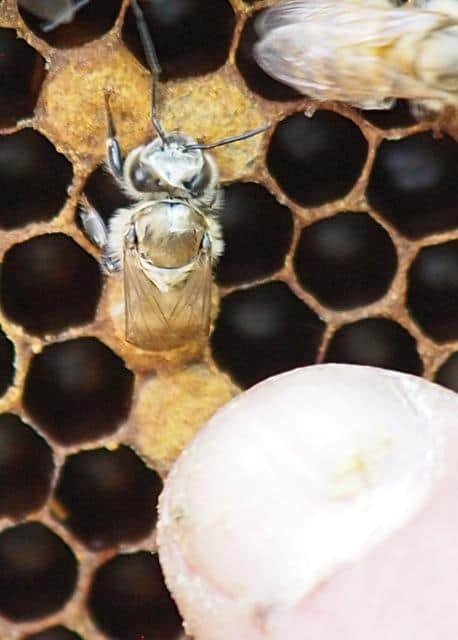Honeybees have it pretty good. They play an essential role in maintaining the environment for all living creatures. Their food and water is “provided” by Earth at no charge. Their wings are conveniently designed to help them gather food. Honeybees can also find readily available shelter at no charge, building their comb in any appropriately sized cavity. Plus their worker bodies have built-in glands that can produce the wax necessary to make these living quarters cozy.
However, the life span of the honeybee is not so attractive. In the best of times, the life expectancy of a summer worker is only about six weeks, while a winter worker might live as long as six months. A lucky queen will sometimes have a multiyear life span, but that doesn’t happen much anymore.
Meanwhile, the colony as a whole—the super organism—faces all sorts of challenges. Some of these challenges apply to all life on Earth:
- bacteria
- disease
- fungi
- parasites
- viruses
Other challenges are the pressures put on them by humans, for humans:
- beekeeper practices (commercial and hobby)
- lack of forage habitat
- plant and insect poisons
You hear repeatedly that the decline of the honeybee population is the result of a complex set of factors. For example, in this report, our government tries to explain how the issue is just too difficult to understand. This is frequently referred to as a scientific work, but begins with this important disclaimer:
This is a report presenting the proceedings of a stakeholder conference organized and conducted by members of the National Honey Bee Health Stakeholder Conference Steering Committee on October 15–17, 2012 in Alexandria, VA. The views expressed in this report are those of the presenters and participants and do not necessarily represent the policies or positions of the Department of Agriculture (USDA), the Environmental Protection Agency (EPA), or the United States Government (USG).
In other words, it’s not a scientific, peer-reviewed article, but conference proceedings. Further, the only opinions expressed are those of the participants.
It’s clearly the case that many factors affect honeybee health. However, the emphasis placed on confusion is meant to distract you from the primary contributor: the massive use of poisons. These impact the nervous and immune systems of insects and render them more vulnerable to the remaining factors that can affect their health—all while making a fortune for the poison manufacturers. The Ontario Beekeepers Association provides a comprehensive list of numerous peer reviewed articles that can help you understand how these poisons affect not only our insect population, but also the creatures who feed on them.
Decades ago, the world recognized the damaging effects of DDT and other pesticides thanks to Rachel Carson’s Silent Spring. In response to public outcry, the agriculture industry implemented a management style called Integrated Pest Management (IPM). In essence, chemical controls would only be resorted to once a real pest problem had been confirmed, and no more chemicals than absolutely necessary to control the confirmed pest would be used. This strategy worked so well that the environment made progress healing. Until 1992, that is. That’s when the first neonicotinoid pesticide, imidacloprid, was approved.
Neonicotinoids are water-soluble systemic poisons. Systemic means the poison becomes part of the plant itself—every part, including stems, leaves, blossoms, nectar, and pollen. Even if these can only be measured in parts per billion, every cell of the plant includes the poison. Any and every creature that eats from a treated plant will be affected. Dr. Henk Tennekes states, “Neonicotinoids bind with acetylcholine receptors, and become ‘false-neurotransmitters,’ where neural transmission switch will turn on even if there is no acetylcholine present.” The effect is cumulative and irreversible.
Bayer Advance 2-in-1 Insect Control Plus Fertilizer—sounds great, right? The front label is very attractive. But if you read the back, you’ll find imidacloprid. What you won’t find is any distinction made between “good” and “bad” insects. It’s poison. It should have a skull and crossbones on the front.
Systemic poisons are, by their very nature, prophylactic. That means they’re used to prevent the pest problem in advance, rather than taking the IPM approach. I say this because in many cases it’s used as seed coating—not to treat a pest problem but to make sure the plant is poison to any pest before it even grows. Systemic poisons are also very long-lived. The aerobic half-life of imidacloprid is 997 days. That’s nearly three years before it metabolizes into half as much poison. And because the poison is water soluble, it travels well. Any contaminated soil will in turn contaminate the plants growing in that soil. This includes not just weeds, but also food crops.
This is all pretty complicated stuff that involves a lot of large, hard-to-pronounce words. If you’ve been patient enough to read this far, you’ll be glad to know that there’s a fairly simple take away: We are rewarding chemical companies with tremendous wealth for covering our planet in poison, and the honeybees are warning us that something terribly wrong is taking place in our environment.
Photo by Steven Kennedy: Worker honeybee emerges into an uncertain world.

